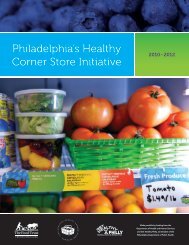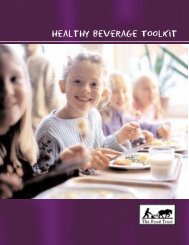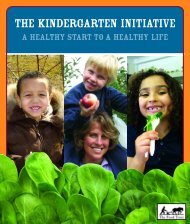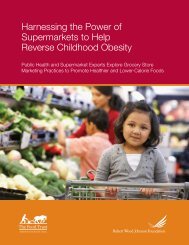The Grocery Gap: Who Has Access to Healthy - The Food Trust
The Grocery Gap: Who Has Access to Healthy - The Food Trust
The Grocery Gap: Who Has Access to Healthy - The Food Trust
You also want an ePaper? Increase the reach of your titles
YUMPU automatically turns print PDFs into web optimized ePapers that Google loves.
PolicyLink<strong>The</strong> <strong>Food</strong> <strong>Trust</strong>37Manjarrez, C., and Cigna, J. <strong>Food</strong> StampParticipation and Market <strong>Access</strong> in the District ofColumbia. Discussion Brief No. 3. Washing<strong>to</strong>n, DC:Urban Institute, 2006. Available at http://www.urban.org/UploadedPDF/311343_dcfoodstamp.pdf.38Moore, L., and Roux, A. “Associations ofNeighborhood Characteristics with the Locationand Type of <strong>Food</strong> S<strong>to</strong>res.” American Journalof Public Health 96 (2006): 325–331.39Moore, L., Roux, A., and Brines, S. “ComparingPerception-Based and Geographic InformationSystem (GIS)-Based Characterizations ofthe Local <strong>Food</strong> Environment.” Journal ofUrban Health: Bulletin of the New YorkAcademy of Medicine 85, no.2 (2008).40Morland, K., and Filomena, S. “Disparities inthe Availability of Fruits and Vegetables BetweenRacially Segregated Urban Neighbourhoods.” PublicHealth Nutrition 10, no.12 (2007): 1481-1489.41Morland, K., Wing, S., Roux, A., andPoole, C. “Neighborhood CharacteristicsAssociated with the Location of <strong>Food</strong> S<strong>to</strong>resand <strong>Food</strong> Service Places.” American Journalof Preventive Medicine 22 (2002): 23–29.42Morland, K., Wing, S., and Roux, A. “<strong>The</strong>Contextual Effect of the Local <strong>Food</strong> Environmen<strong>to</strong>n Residents’ Diets: <strong>The</strong> Atherosclerosis Riskin Communities Study.” American Journal ofPublic Health 92, no.11 (2002): 1761-1767.43Mor<strong>to</strong>n, L., and Blanchard, T. “Starved for<strong>Access</strong>: Life in Rural America’s <strong>Food</strong> Deserts.”Rural Realities 1, no.4 (2007). Available at www.ruralsociology.org/pubs/ruralrealities/issue4.html.44Neckerman, K., Bader, M., Purciel, M., andYousefzadeh, P. Measuring <strong>Food</strong> <strong>Access</strong> in UrbanAreas. New York, NY: Columbia University, 2009.Available at http://www.npc.umich.edu/news/events/food-access/neckerman_et_al.pdf.45Powell, L., Auld, C., Chaloupka, F., O’Malley,P. M., and Johns<strong>to</strong>n, L. D. “AssociationsBetween <strong>Access</strong> <strong>to</strong> <strong>Food</strong> S<strong>to</strong>res and AdolescentBody Mass Index,” American Journal ofPreventive Medicine 33, no.4 (2007).46Powell, L., Slater, S., Mirtcheva, D., Bao, Y.,and Chaloupka, F. “<strong>Food</strong> S<strong>to</strong>re Availabilityand Neighborhood Characteristics inthe United States.” American Journal ofPreventive Medicine 44 (2007): 189–195.47Rundle, A., Neckerman, K., Freeman, L.,Lovasi, G., Purciel, M., Quinn, J., Richards,C., Sircar, N., and Weiss, C. “Neighborhood<strong>Food</strong> Environment and Walkability PredictObesity in New York City.” EnvironmentalHealth Perspectives 117 (2009): 442–447.48Sacramen<strong>to</strong> Hunger Coalition. <strong>The</strong> Avondale/GlenElder Community <strong>Food</strong> Assessment. <strong>Food</strong> Securityin a South Sacramen<strong>to</strong> Neighborhood. Sacramen<strong>to</strong>,CA: Sacramen<strong>to</strong> Hunger Coalition, 2004.49Shaffer, A. <strong>The</strong> Persistence of L.A.’s <strong>Grocery</strong> <strong>Gap</strong>:<strong>The</strong> Need for a New <strong>Food</strong> Policy and Approach <strong>to</strong>Market Development. Center for <strong>Food</strong> and Justice,Urban and Environmental Policy Institute, OccidentalCollege. 2002. Available at www.departments.oxy.edu/uepi/publications/the_persistence_of.htm.50Sharkey, J., and Horel, S. “NeighborhoodSocioeconomic Deprivation and MinorityComposition are Associated with BetterPotential Spatial <strong>Access</strong> <strong>to</strong> the Ground-Truthed<strong>Food</strong> Environment in a Large Rural Area.” <strong>The</strong>Journal of Nutrition 138 (2008): 620–627.51Sharkey, J., Scott, H., Daikwon, H., andHuber, J. “Association Between NeighborhoodNeed and Spatial <strong>Access</strong> <strong>to</strong> <strong>Food</strong> S<strong>to</strong>res andFast <strong>Food</strong> Restaurants in Neighborhoods ofColonias.” International Journal of HealthGeographics 8, no.9 (2009): 1-17.52Sloane, D., Diamount, A., Lewis, L., et al.“Improving the Nutritional Resource Environmentfor <strong>Healthy</strong> Living Through Community-BasedParticipa<strong>to</strong>ry Research.” <strong>The</strong> Journal of GeneralInternal Medicine 18 (2003): 568–575.53Small, M. L, and McDermott, M. “<strong>The</strong> Presenceof Organizational Resources in Poor UrbanNeighborhoods: An Analysis of Average andContextual effects.” Social Forces 84 (2006):1697-1724.54Smith, D. <strong>Food</strong> Deserts in the Willamette: A Studyof <strong>Food</strong> <strong>Access</strong> in Lane County, Oregon. [Master’sthesis]. Eugene, OR: University of Oregon, 2003.55Sparks, A., Bania, N., and Leete, L. “Finding<strong>Food</strong> Deserts: Methodology and Measuremen<strong>to</strong>f <strong>Food</strong> <strong>Access</strong> in Portland, Oregon.” Paperprepared for Institute of Medicine, Workshopon the Public Health Effects of <strong>Food</strong> Deserts,January 26, 2009. Washing<strong>to</strong>n, DC, 2009.34






